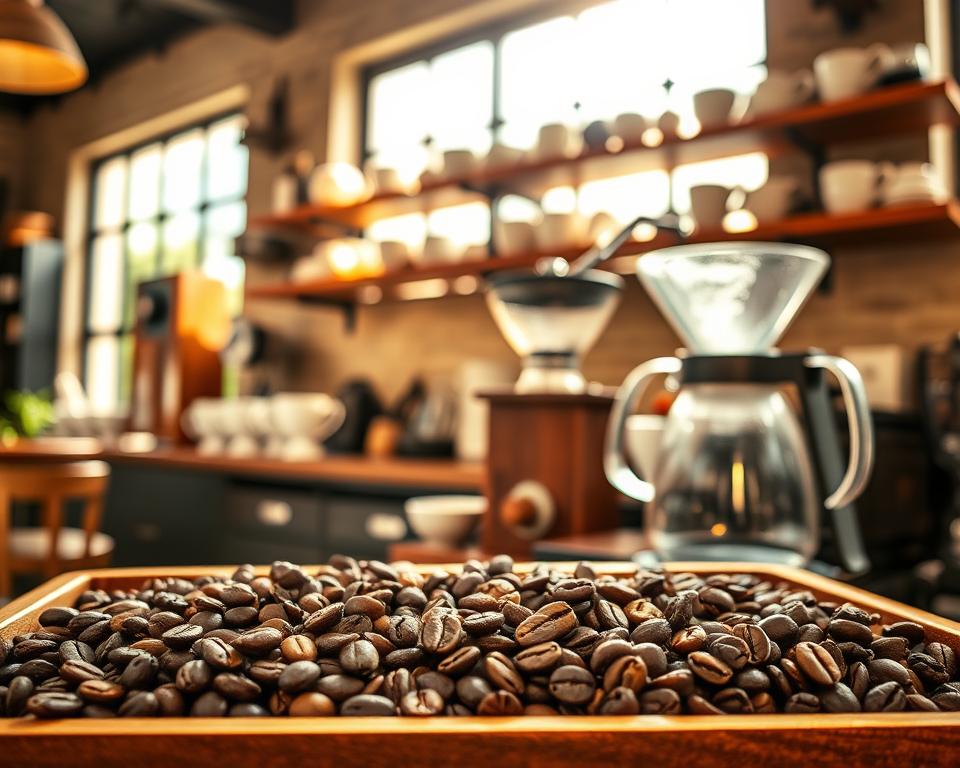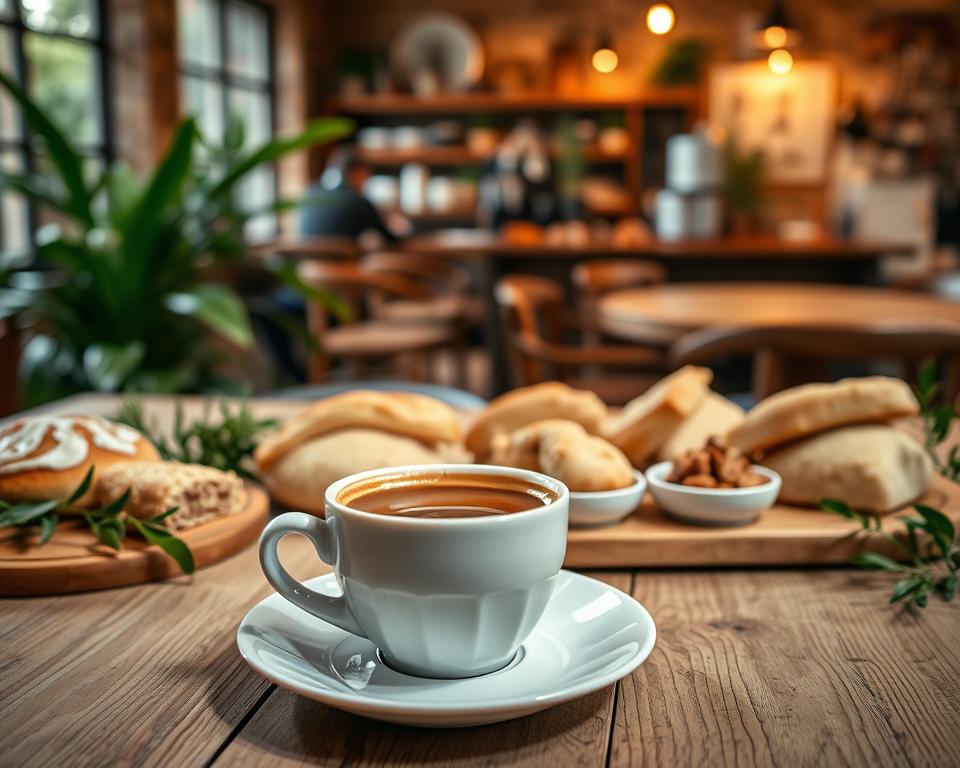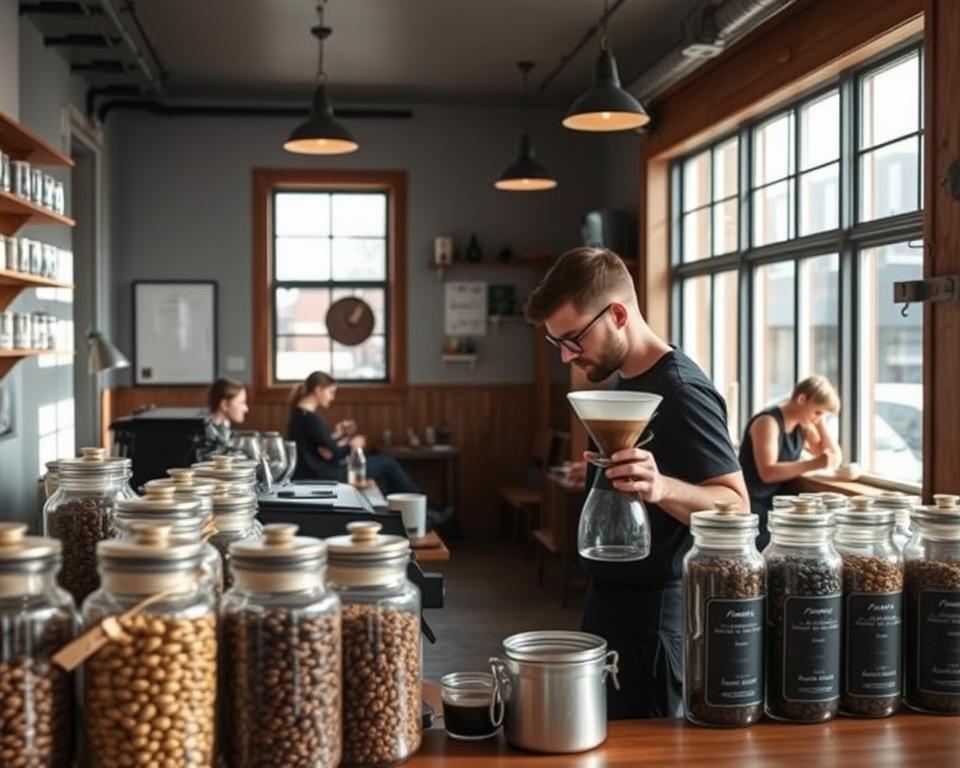Welcome to the world of small-batch coffee, where every cup is a testament to the art of precision and quality. This method involves roasting a small amount of coffee beans at a time, typically less than 50 pounds. It allows for precise control over the roasting process. This approach results in a more unique and flavorful coffee, often referred to as artisan coffee or handcrafted coffee.
With small-batch coffee, you can experience the rich flavors and aromas that come from high-quality beans. These beans are carefully sourced and roasted to bring out the best in every cup. The smaller scale of roasting facilitates greater experimentation with different beans and roasting profiles. This results in a more diverse range of coffee flavors. Whether you’re a coffee aficionado or just beginning to explore the world of coffee, small-batch coffee offers an experience that is both personal and profound.
As consumers become more discerning about their coffee, the demand for small-batch coffee is on the rise. Many seek out unique and flavorful coffee experiences. With the emphasis on quality and craftsmanship, small-batch coffee roasters are leading the way in the specialty coffee sector. The trend towards small-batch coffee roasting has also led to a 30% increase in the number of small roasteries opening in urban areas over the past five years. This makes it easier for consumers to access and enjoy small-batch coffee.
Introduction to Small-Batch Coffee
In the world of coffee, small-batch coffee is becoming increasingly popular. Many coffee lovers seek out the unique flavors and high-quality beans that small-batch coffee roasters have to offer. With the focus on artisan coffee and handcrafted coffee, small-batch coffee roasters are able to bring out the best in every cup. This makes it a truly unique and flavorful experience.
Key Takeaways
- Small-batch coffee roasting involves roasting less than 50 pounds of coffee beans at a time, allowing for precise control over the roasting process.
- Small-batch coffee offers a more unique and flavorful experience, with a focus on quality and craftsmanship.
- The demand for small-batch coffee is on the rise, with a growth rate of approximately 12% annually in the specialty coffee sector.
- Small-batch coffee roasters are leading the way in sustainable and ethical sourcing practices, with many engaging in direct trade relationships with coffee farmers.
- Consumers are willing to pay a premium for small-batch coffee, with prices often ranging from $15 to $30 per pound.
- Small-batch coffee is becoming increasingly popular, with a 30% increase in the number of small roasteries opening in urban areas over the past five years.
What is Small-Batch Coffee?
Small-batch coffee focuses on quality and freshness above all. It’s known for its unique flavors, thanks to the selection of high-quality beans and precise roasting. Specialty coffee is a term often used to describe this type, highlighting quality over quantity.
The core of small-batch coffee lies in the small-batch roasting method. This involves roasting coffee in amounts under 25 pounds. It offers a personalized and artisanal coffee experience, as each batch is monitored to enhance the coffee’s unique flavors.
Definition and Characteristics
Small-batch coffee is all about quality and freshness. Beans are roasted just before they reach consumers, boosting their freshness. It also uses organic and pesticide-free beans, reducing harmful chemical exposure. The roasting and packaging are quick, preserving the coffee’s antioxidants.
The History Behind Small-Batch Production
The history of small-batch production stems from a desire for a more personal coffee experience. Small roasters often form direct trade relationships with farmers, ensuring fair prices and community development. The online market has grown, making unique specialty coffee options more accessible. This has led to the rise of micro-roastery operations, offering a variety of specialty coffee choices.
Why Choose Small-Batch Coffee?
Many consumers are now opting for small-batch coffee for its distinct flavors and benefits. This type of coffee is roasted in quantities under 25 pounds, enhancing its taste. It offers a range of flavors, from fruity and floral to rich and earthy. This quality is often linked to gourmet coffee, known for its refined and unique tastes.
Small-batch coffee is also celebrated for its ethically sourced beans. These beans come directly from farmers, ensuring fair prices and community development. This direct trade supports sustainable practices. Many roasters focus on single-origin coffee beans, known for their distinct flavors and high quality.
The benefits of small-batch coffee include:
- Unique flavor profiles and high-quality beans
- Support for local businesses and fair trade practices
- Environmentally friendly and sustainable production methods
- Higher antioxidant preservation due to freshness
Choosing small-batch coffee offers a rich experience. It brings unique flavors, ethically sourced beans, and health benefits. For coffee enthusiasts, it’s a great way to enhance their daily brew.
The Small-Batch Coffee Process
Small-batch coffee stands out for its meticulous production, focusing on high-quality beans and precise roasting. This dedication to detail distinguishes it from mass-produced coffee, offering a richer flavor. The art and science behind small-batch coffee require a deep understanding of beans and roasting techniques.
The quality of beans is crucial for a great cup of coffee. Artisan coffee roasters meticulously select beans that are high-quality and sustainably sourced. This supports local farmers and reduces environmental impact. Choosing handcrafted coffee not only enhances the coffee experience but also promotes sustainability in the industry.
Some key benefits of the small-batch coffee process include:
- Precise control over roasting parameters, allowing for a more consistent and flavorful roast
- The ability to experiment with different beans and roasting profiles, resulting in a more diverse range of coffee flavors
- Greater customization and attention to quality, ensuring that each batch is closely monitored for optimal roasting levels
In conclusion, the small-batch coffee process is a labor of love, requiring a deep passion for coffee and a commitment to quality. By understanding the care and attention that goes into creating each cup of small-batch coffee, consumers can appreciate the craftsmanship and dedication that sets this type of coffee apart from the rest.
Popular Small-Batch Coffee Brands
In the realm of specialty coffee, several small-batch brands have emerged as leaders. With over 3,212 coffee roasters in the USA, selecting the finest can be daunting. Yet, some roasters have distinguished themselves through their exceptional offerings and blends. Coffee Bros., for example, is renowned for its high-quality coffees, scoring between 86-90+ points.
Onyx Coffee stands out for its use of solar energy in roasting and shipping. JBC Coffee Roasters has also garnered acclaim, with numerous 90+ point coffee scores from Coffee Review. Exploring the best coffee blends is an exciting journey. Brands like Red Rooster focus on sustainability, using biodegradable bags and compostable products. Mostra Coffee, on the other hand, has won the US Coffee Championships, showcasing their excellence.
Here are a few more notable small-batch coffee brands:
- Abraço: Known for its community engagement and quality sourcing of coffee
- Prodigal Coffee: Founded by Scott Rao, who has over 30 years of experience in the coffee industry
- YellowBand Coffee Roasters: Donates $2 from each bag of their Bee in Nature coffee to the Southern Conservation Trust’s pollinator gardens
These brands are at the forefront of quality, innovation, and sustainability. They are ideal for those eager to dive into the specialty coffee and small-batch roasting world.
How to Brew Small-Batch Coffee at Home
Brewing small-batch coffee at home is a delightful experience for coffee lovers. It allows them to enjoy their favorite gourmet coffee in their own space. With the right tools and techniques, you can brew single-origin coffee that rivals professional coffee shops.
To begin, investing in a burr grinder and a scale is crucial. These tools ensure your coffee is ground correctly and the coffee-to-water ratio is perfect. A 15:1 ratio (20g coffee to 300g water) is a good starting point for many methods.
Popular brewing methods include pour-overs, French presses, and Chemex. Each method has unique characteristics and requirements. Pour-overs need a medium-coarse grind and water at 200 degrees Fahrenheit. French presses require a coarser grind and slightly cooler water.
When brewing, consider the coffee beans’ quality and origin. Choose ethically sourced, freshly roasted beans with a high quality rating. This ensures your coffee is not only tasty but also sustainable and responsible.
By following these tips, coffee enthusiasts can enjoy high-quality small-batch coffee at home. Whether you prefer single-origin or gourmet blends, brewing at home lets you fully appreciate your coffee’s flavor and aroma.
Exploring Different Coffee Varieties
Coffee lovers can start a journey to find unique tastes by trying different coffee types. Single-origin coffee gives a unique look into a specific area or farm’s traits. Blends, on the other hand, mix flavors for a complex taste. This variety in coffee is key to small-batch coffee, letting people taste a wide range of flavors.
Some notable coffee types include single-origin coffees from Ethiopia, known for their floral and fruity tastes. Sumatra is famous for its earthy and spicy flavors. These tastes come from the climate, altitude, and soil where the coffee grows. Handcrafted coffee, like that from Liberty Beans Coffee, uses rare beans and careful roasting to bring out the flavors.

Artisan coffee roasters mix small-batch roasting with single-origin beans to improve taste. This lets people enjoy the unique flavors of each coffee type, whether it’s single-origin or a blend. Knowing the differences between these types helps coffee lovers broaden their taste and enjoy the variety of small-batch coffee.
Key traits of small-batch coffee include:
- Unique flavor profiles influenced by region and farm
- High-quality beans sourced from distinct locations
- Meticulous roasting processes to enhance flavor complexity
- Emphasis on freshness and quality
As people learn more about small-batch coffee, they’re more willing to pay for high-quality, artisan coffee. The growth of the small-batch coffee industry shows a change in how people see coffee. Now, it’s viewed as a complex and sophisticated drink, not just a simple beverage.
The Impact of Freshness in Small-Batch Coffee
Freshness is key in specialty coffee, affecting both flavor and quality. Small-batch roasting, under 25 pounds, offers precise control. This leads to consistent, high-quality coffee flavors. Micro-roasteries focus on unique blends, emphasizing quality.
Unlike mass-produced coffee, small-batch is roasted in small amounts. It reaches consumers quickly, preserving volatile compounds. To keep coffee fresh, understanding roast dates and proper storage is crucial. Store it in an airtight container in a cool, dark place.
Understanding Roast Dates
Roast dates are vital for coffee freshness. Coffee is best when roasted within a month. Checking the roast date ensures recent roasting, enhancing flavor.
Storage Tips for Optimal Freshness
To keep small-batch coffee fresh, follow these storage tips:
- Store coffee in an airtight container to prevent air, moisture, and light from affecting the beans.
- Keep coffee in a cool, dark place, such as a pantry or cupboard.
- Avoid storing coffee in the refrigerator or freezer, as this can cause the beans to become stale.
Pairing Small-Batch Coffee with Food
Exploring the world of gourmet coffee and food pairing reveals a vast array of options. Whether it’s with sweet pastries or savory eggs, single-origin coffee can enhance a variety of dishes. The key is to match the coffee’s flavor profile with the food’s characteristics for a harmonious taste experience.
For breakfast, ethically sourced coffee pairs well with items like avocado toast or butter croissant. These pairings highlight the coffee’s light-bodied nature. On the other hand, rich desserts like chocolates or fruity treats are perfectly complemented by the bold flavors of single-origin coffee.

- Light roast coffee with citrus fruits and desserts
- Medium roast coffee with balanced flavor profiles and moderate acidity
- Dark roast coffee with bold, robust flavors and lower acidity
By understanding the coffee’s flavor profile and the food’s characteristics, enthusiasts can craft unique pairings. Whether you’re drawn to gourmet coffee or ethically sourced coffee, the essence lies in experimentation. Find the perfect match that resonates with your palate.
Sustainable Practices in Small-Batch Coffee
Small-batch coffee goes beyond just the beverage; it’s about the environmental impact it leaves. Eco-friendly sourcing and waste reduction are key to minimizing its ecological footprint. By focusing on sustainability, small-batch roasters support organic farming, cut down on carbon emissions from transport, and foster a greener coffee industry.
Roasters can lessen their environmental impact by choosing local or nearby bean sources. This move significantly slashes the carbon footprint from transport and distribution. Small-batch coffee also champions small farmers by offering them fairer prices. This support boosts their livelihoods and contributes to the well-being of coffee communities.
Here are some benefits of sustainable practices in small-batch coffee:
- Promoting organic farming methods, which reduces the environmental impacts associated with traditional coffee cultivation
- Reducing waste in coffee production, which helps minimize the carbon footprint of the industry
- Supporting small-scale farmers, which contributes to improved livelihoods in coffee-growing communities
In conclusion, sustainability is crucial for the small-batch coffee sector. By emphasizing eco-friendly sourcing, waste reduction, and organic farming, roasters can make the industry greener. As consumers grow more conscious of their environmental impact, demand for sustainable coffee will rise. This trend will push the industry towards more eco-friendly practices.
| Practice | Benefit |
|---|---|
| Eco-friendly sourcing | Reduces carbon footprint associated with transportation and distribution |
| Reducing waste | Minimizes environmental impact of coffee production |
| Promoting organic farming methods | Reduces environmental impacts associated with traditional coffee cultivation |
Building a Small-Batch Coffee Community
Coffee has long been a social lubricant, fostering connections among diverse individuals. In the context of specialty coffee, this social aspect is even more pronounced. Small-batch roasting and micro-roastery operations often serve as community hubs. By supporting local roasters, consumers enjoy high-quality, unique coffee blends. They also contribute to the growth of local businesses and strengthen community ties, as seen in the article supporting local roasters.
Some notable examples of community-building initiatives include:
- Local coffee tastings and events, which provide a unique opportunity for people to come together and share their passion for coffee.
- Online forums and social media platforms, which allow coffee enthusiasts to connect with each other, share knowledge, and stay up-to-date on the latest trends and developments in the world of small-batch coffee.
These initiatives not only foster a sense of community among coffee enthusiasts but also promote the growth of local businesses. They contribute to the development of a vibrant coffee culture. As the demand for high-quality, unique coffee blends continues to rise, the importance of building a small-batch coffee community will only continue to grow.
The Future of Small-Batch Coffee
As the demand for high-quality,
gourmet coffee
continues to rise, the future of small-batch coffee is filled with promise. Small-batch roasters are set to lead, using cutting-edge technologies and sustainable methods. They aim to deliver outstanding
single-origin coffee
and distinct flavors.
The rise of artificial intelligence (AI) in roasting is a notable trend. Smart roasting machines are gaining traction, enabling roasters to replicate and innovate. AI could refine roasting, enhancing consistency and quality.
Small-batch roasters will also intensify their focus on
ethically sourced coffee
. They will strengthen direct trade with farmers, ensuring fair wages and sustainable practices. Biodegradable packaging is becoming the norm, reducing environmental harm.
Consumer preferences for unique coffee experiences will surge. Small-batch roasters will experiment with new fermentation techniques and blends. This will provide coffee lovers with a wide range of flavors to explore.
FAQ
What is small-batch coffee?
What are the characteristics of small-batch coffee?
Why should I choose small-batch coffee?
How is small-batch coffee processed?
What are some notable small-batch coffee brands in the US?
How can I brew small-batch coffee at home?
What are the different coffee varieties in small-batch coffee?
How does freshness impact small-batch coffee?
How can I pair small-batch coffee with food?
How can small-batch coffee be more sustainable?
How can I build a community around small-batch coffee?
What are the future trends in small-batch coffee?

Tina Avila is a writer at WyNeeds, where she delves into the rich and diverse world of coffee. With a passion for flavors and brewing techniques, she brings insightful articles covering everything from coffee culture and bean origins to expert tips on making the perfect cup. Her goal is to inspire and educate coffee enthusiasts, helping them enhance their appreciation for every sip.

